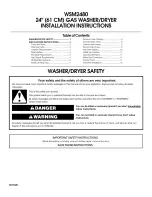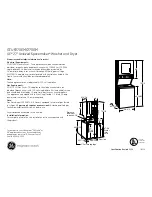
installing your dryer
_9
DUCTING REQUIREMENTS
•
Use a 4-inch (10.2 cm) diameter rigid aluminum or rigid galvanized steel duct.
•
Do not use a smaller duct.
•
Ducts larger than 4 inches (10.2 cm) in diameter can result in increased lint accumulation.
Lint accumulation should be cleaned regularly.
•
If a flexible metal duct must be used, use the type with a stiff sheet metal wall. Do not use a flexible duct
with a thin foil wall. Serious blockage can result if the flexible metal duct is bent too sharply.
•
Never install any type of flexible duct in walls, ceilings, or other concealed spaces.
•
Only a rigid or flexible metal duct should be used for exhausting.
•
Keep the exhaust duct as straight and short as possible.
•
Secure joints with duct tape. Do not use screws.
•
DO NOT EXHAUST DRYER INTO ANY WALL, CEILING, CRAWL SPACE, OR CONCEALED SPACE OF
A BUILDING, GAS VENT, OR ANY OTHER COMMON DUCT OR CHIMNEY. THIS COULD CREATE A
FIRE HAZARD FROM LINT EXPELLED BY THE DRYER.
•
A plastic flexible duct can kink, sag, be punctured, reduce airflow, extend drying times, and affect dryer
operation.
•
Exhaust systems longer than recommended can extend drying times, affect machine operation, and
may collect lint.
•
The exhaust duct should end with an exhaust hood with a swing-out damper to prevent back drafts and
entry of wildlife. Never use an exhaust hood with a magnetic damper.
•
The hood should have at least 12 inches (30.5 cm) of clearance between the bottom of the hood and
the ground or other obstruction. The hood opening should point down.
•
Never install a screen over the exhaust outlet.
•
To avoid lint buildup, do not exhaust the dryer directly into a window well. Do not exhaust under a house
or porch.
•
If exhaust ductwork must run through an unheated area, the duct should be insulated and slope slightly
down towards the exhaust hood to reduce condensation and lint buildup.
•
Inspect and clean the interior of the exhaust system at least once a year. Unplug the power cord before
cleaning.
•
Check frequently to be sure the exhaust hood damper opens and closes freely.
•
Check once per month, and clean at least one time per year. Note: If clothes are not getting dry, then
check ducting for obstructions.
ELECTRIC AND GAS DRYER
Weather Hood Type
Recommended
Use only for short-run installation
4” (10 .16 cm)
2.5” (6.35 cm)
No. of 90° elbows
Rigid
Metallic Flexible*
Rigid
Metallic Flexible*
0
24.4 m (80 ft.)
12.4 m (41 ft.)
22.6 m (74 ft.)
10.1 m (33 ft.)
1
20.7 m (68 ft.)
11.2 m (37 ft.)
18.9 m (62 ft.)
8.8 m (29 ft.)
2
17.4 m (57 ft.)
10.1 m (33 ft.)
15.5 m (51 ft.)
7.6 m (25 ft.)
3
14.3m (47 ft.)
9.0 m (29 ft.)
12.5 m (41 ft.)
6.5 m (21 ft.)
*
Do not use non-metallic flexible duct.
01 installing your dryer
DV220AE-02810B_EN.indd 9
2010-04-13 ¿ÀÈÄ 2:51:37










































